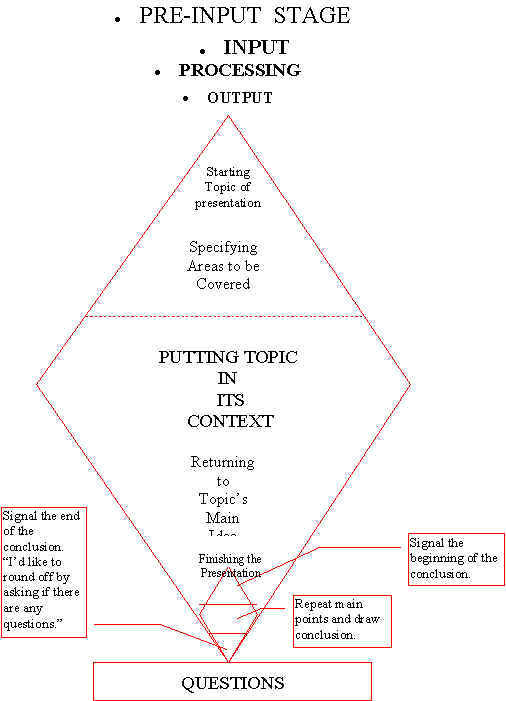|
Here are some tips that will help you prepare an effective
oral presentation. |
|
What to do |
Other Suggestions |
PRE-INPUT STAGE
Choose a topic |
- Select a topic which you are familiar with and for which
there are adequate materials available.
- Make an outline of the main points you intend to deal with.
|
If you are not so sure about what topic to choose, ask your teacher
for help. He/she might have some valuable ideas. |
Input stage
Gather your Materials |
Go to the library and find books, periodicals, magazines, pictures,
and even videos that will provide you with information about
your topic. |
If you are not sure about where to start your search, we suggest
you go to the front desk in the library. The librarians will
assist you in locating the materials in the card index, but they
will not do the work for you. When you find relevant material,
you may find it useful to photocopy it. |
Processing
stage |
Skim the materials, select the data that you feel is relevant
to your presentation and make notes. Do not copy straight
from the text. |
Note: Teachers’ office hours have been assigned to
prepare their lessons and to help their students. In most cases,
teachers are more than happy to help. Make an appointment to
see your teacher during office hours. |
Get
Organized |
- Organize your materials into a beginning, body and conclusion.
- Put your information into a note outline or write each point
on separate cards.
- Make sure that you follow a logical sequence and that it
makes sense. Prepare structuring language to help the listener.
Make sure that any visual aids you are going to use are in
place before you start talking. |
See table 1. Structuring Language - Useful Phrases.
If you are going to use transparencies, charts, or pictures,
keep them simple. |
Output
stage
Present
Your
Topic |
- State clearly what you intend to do. Be clear about your
aims.
Do not read out your presentation. Have your information prepared
and organized so that you can refer to it quickly without interrupting
your talk. Tell your audience what you intend to say and signal
that you are moving from one point to the next. |
Build your audience’s expectations and motivation. Let
them know that what you are going to say is interesting and easy
to understand. Be enthusiastic and positive. Look confident and
speak clearly and with confidence. Never start with an apology.
Remember: you are the expert at that moment in the
classroom. An effective presentation is one which is clear about
its objectives. |
Use
Visual Aids |
If you are going to present numbers or complex information,
it is useful to use diagrams, graphs or tables. Your information
can be put on the blackboard , wall charts or transparencies
using an overhead projector (OHP). |
Before your talk be sure you are familiar with any equipment
you will be using.. |
|
Voice |
- Speak so that everyone in the classroom can hear you.
- Avoid speaking monotonously, and be sure about the pronunciation
and meaning of words you are not familiar with. If you find such
words, ask your teacher in advance and be ready to explain their
meaning to your audience at the appropriate time.
- Talk to your audience, avoid looking at one particular person,
the overhead, the floor or the ceiling in the classroom.
|
Your voice is your means of communicating your thoughts. Use
it so that you keep your listeners’ attention and do not
turn them off. Remember: that speaking too loudly is just
as bad as speaking too softly.
Look around the classroom and keep eye-contact with your audience. |
|
Posture |
Place yourself somewhere where every one can see you, but near
your audiovisual aids, so as to be able to refer to them. It
is helpful to vary your position as well as your posture. |
Remember: your body also talks so use it to your advantage.
For example do not be afraid to smile. This will relax your audience |
|
Timing |
Keep an eye on the time and do not exceed the time limit given
by your teacher. |
Ask a friend to signal to you when to finish. This will save
you from embarrassment. |
|
Conclusion |
- This is an essential part of your presentation. Summarize
your talk and re-state the points you have tried to present.
- Use appropriate phrases to conclude your talk.
|
When you have finished ask the audience for questions. |
|
Answer Formal Questions |
- Give direct answers, be concise and to the point.
Be sure to clarify points raised by your audience regarding
matters you mentioned in your talk. |
Do not be afraid to ask for clarification if you do not understand
the question. The teacher may be able to help you to answer difficult
questions. Be warm, involved and understanding. |
|
Evaluation |
The purpose of this is to give you feedback regarding the
effectiveness of your talk so that your presentation becomes
a valuable learning experience. |
Be sure you know the criteria of assessment that your teacher
will use to asses your presentation . See "Table 2 Assessment
Sheets." |
|
Other Suggestions |
- Become familiar with the vocabulary you will be using. If
you are not sure about the pronunciation of a word or phrase,
look it up in the dictionary. Do not leave things to the last
minute.
Practice your talk before you deliver it. Ask a friend or
someone you trust to be your audience and to give you feedback.
Time yourself so that you are able to give your talk within the
time limit set by your teacher. |
